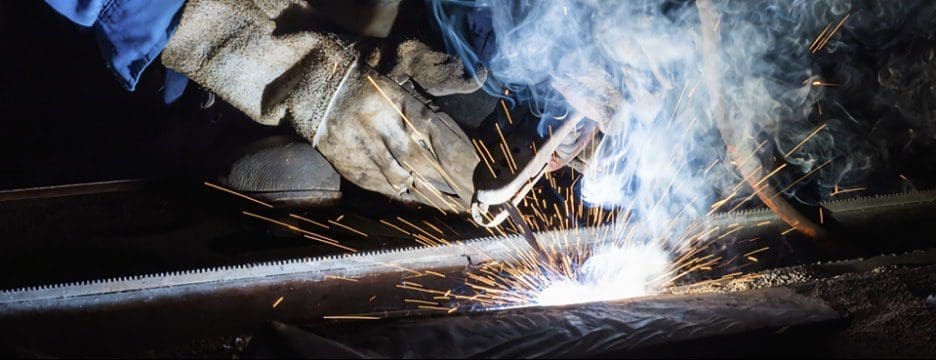Join us on THEO’s blog where expert Joe Dallarosa examines welding safety, comparing traditional methods versus handheld laser welding. Discover essential safety measures and understand the risks associated with each technique, offering a clear perspective on maintaining safe welding environments in both traditional and modern settings.
In this article we will focus on three different facets of welding: conventional electrical welding, laser welding, and the working environment where this welding is taking place. To further limit the scope of this article we will focus on manual, non-automated welding applications.
Hazards of Traditional Electrical Welding
In traditional electrical welding there are several areas where a person needs to protect themselves from potential injuries and hazards to various parts of the body. The process of welding creates a bright arc, a pool of molten metal, and a plume of smoke consisting of metal and/or flux particulates as well as inert gas to shield the liquid metal during the process.
Protecting Eyes and Skin from Welding Arcs
The bright arc can cause eye damage in two ways. Ultraviolet light reflected by the plasma can cause serious damage to exposed eyes and skin. Additionally, the light of the arc itself can be brighter than the sun and can lead to arc flash and “welder’s eye” with sufficient exposure. Welding masks are fitted with shaded lenses ranging from a shade 3 for grinding up to a shade 13 for extreme amounts of arc light as seen in heavy fabrication. This darkened lens is designed to filter out the dangerous light before it has a chance to reach the eyes or skin of the welding operator.

Essential Personal Protective Equipment for Welders
In addition to a mask, Personal Protective Equipment (PPE) is worn to provide full body protection from damage due to UV light, smoke and other fumes, heat and metal spatter generated by welding. This may consist of a respirator or particulate-rated breathing mask, leather or synthetic flame-resistant gloves, a flame-resistant apron, jacket or sleeves, sturdy flame-resistant boots and safety glasses, as well as hearing protection if necessary. These can all be bought online or from any typical welding supplier. A small initial investment in and proper use of this equipment provides a strong foundation of protection against common welding hazards and can minimize damage and injuries in case of an accident.
Mitigating Risks with Fume Extraction Systems
In addition to breathing protection worn by welding operators, many workplaces invest in fume extraction systems designed specifically for welding. While some alloys give off more toxic fumes than others, all metals produce fumes during welding that can cause injury or tissue damage given enough exposure. For example, Chromium is a component in stainless steel, nonferrous alloys, and chromate coatings. Chromium can be converted to a hexavalent state CR (VI) during the welding process and these fumes are highly toxic. Repeated exposure to “hex chrome” can lead to symptoms similar to those seen in Parkinson’s disease and which may prove irreversible. When in doubt of the efficacy of a fume extraction system in the workplace, it’s advised that an occupational safety professional be consulted to help determine the best solution for a workplaces’ specific needs.
There are hundreds of books and articles on welding safety along with codes from OSHA that can provide further insight on welding safety.
Safety Concerns with Handheld Laser Welding
Handheld welding with a laser has the same hazards as listed above with conventional electrical welding. The laser uses light to deliver heat into the workpiece. This laser light is 1.08 microns and exists on the infrared, invisible part of the light spectrum. This wavelength is easily absorbed by metal and quickly forms a small but very stable weld pool. When an application allows for laser welding, the process can prove itself as cost effective in producing similar weld results to traditional methods at a faster rate, with high electrical to light conversion efficiencies.
Addressing Laser Welding Hazards
There are associated dangers to the human body when using this laser light but these can be overcome by using the right protective gear. The biggest danger is damage to the eye. Today’s fiber laser welders use a Class 4 laser and this as shown below can cause severe damage as it is an open beam with substantial power.

Since this class 4 laser is an invisible laser beam, the human eye has no self-protective reflex like looking away or shutting one’s eyes which occurs in the case of being “flashed” by a traditional welding arc. Even brief direct exposure to the eye can cause permanent damage to the cornea, retina and optic nerve. This laser light can come from the weld pool where the laser tool is directed or from the beam bouncing off a reflective surface, redirecting a secondary beam of light.
Enhancing Safety with Modern Technology in Welding
While these hazards may seem extreme, the good news is that as more lasers are being implemented into our everyday lives and modern infrastructure, safety technology is evolving alongside these tools to ensure their smooth operation and meet the needs of the humans and environment which they were meant to serve.
Laser Safety Features and Protective Gear
Today’s handheld laser welding machines include safety features that prevent the laser from being fired anywhere other than the workpiece. Laser light that is not absorbed in the weld is referred to as scattered light. If necessary, there are recordable data points and formulas that can determine what the intensity (hazard level) of this scattered light is related to the distance from the weld pool.
To protect the eyes of the welder and others that maybe in the area there is laser specific eyewear with lenses formed with absorbing glass or plastic that filters out and blocks the laser light before it reaches the eye. By federal law and international standards, laser eyewear is to include ratings that tell the level of attenuation (blocking power) either printed or stamped on the lens or frame. It is good practice to source laser eyewear from reputable vendors with an OD rating of 10 to the 6th or better.
Conclusion: Ensuring Safe Welding Practices
With the right PPE and knowledge of the hazards involved, laser welding is a safe process for both the welding operator and those in the surrounding area.
Check back soon for our article on creating a laser safe area.







